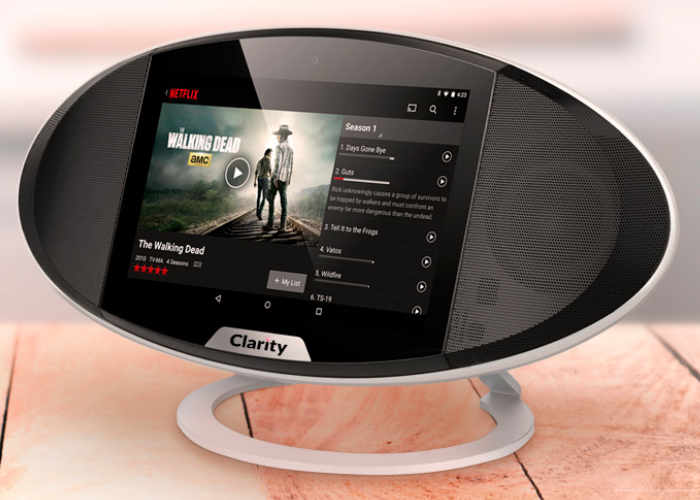The battle for smart home automation is intensifying, as Amazon Alexa and OK Google target consumers across multiple devices. With an Amazon Echo touchscreen rumored to be in the works, startup Pan Sea Co. is releasing a $200 Android-powered touchscreen Clarity Speaker that will support both Alexa and Google voice services in June. The 7-inch device is being marketed as the central hub for the automated home, enabling users to access Google Now, Google Assistant, Alexa, entertainment services like Spotify, Pandora, Netflix, Google Play and communication apps like Skype. It’s available for pre-order at $150.
“People like the new, simple ways to interact with technology,” Dake Liu, CEO of Pan Sea Co., told [a]listdaily. “AI voice service is currently at the forefront, but not the only one that people are focused on. When people communicate with modern interactive technology, it should feel more natural than if you were just interacting with a machine. We loved the thought of people being able to see and speak to one another, so we added touchscreen into the smart speaker.”
With Clarity, users can control and manage every aspect of the connected home. Using voice commands to control Alexa or Google, or leveraging the 7-inch touchscreen, users can control a range of devices including Nest, TP-Link, Samsung SmartThings, Insteon, Ecobee, Wemo and Hue Personal Wireless Lighting.
“AI voice is evolving into the control center for the Internet of Things, a lot of IOT product will be in your home in the coming years,” Liu said. “Developing an IOT product that can be controlled by one hub was important so we could stand out in the crowd. Clarity is a great device that seamlessly connects all IOT products together and enhances your quality of life.”
Pan Sea Co. developed a special app to connect with the Alexa voice service and opened the OK Google function from the Android system. Liu said this makes it easy to switch between the two services. If consumers want to access Amazon Alexa, they would touch the Alexa app on the Clarity Speaker screen and then say the wake-up word, “Alexa,” with the instruction. For Google, you would touch the microphone on the display screen, say “OK Google” and give it an instruction.
“We don’t have detailed information about the rumored Amazon Echo, but we believe Clarity will be on the market ahead of the device,” Liu said. “Clarity is also portable and unlike Amazon Echo, does not need to be plugged in for operation. This means Clarity can be enjoyed anytime and anywhere. Finally, again as it uses the Android OS, Clarity will have access to more apps than a device on an Amazon-only platform.”
The first wave of Clarity products are going to the 1,500 backers who crowdfunded $250,000 on IndiGogo to get the ball rolling. That exceeded the campaign goal by over 400 percent.
“The crowdfunding campaign made us really identify our core selling points and areas of differentiation,” Liu said. “It has also given us a platform to reach, and be scrutinized by, tech enthusiasts and early adopters.”
The company also learned the importance of respecting all of the audiences out there and delivering a valued product to them. It employed surveys and A/B tests with this crowdfunding audience to make decisions moving forward.
Liu said the company will continue to target consumers who are looking for connected home devices, who are interested in Alexa-enabled devices, but not necessarily an Amazon product, and users who are looking to diversify their lifestyles with a stylish, yet functional connected home device.
Liu said the Clarity brand means, “Making machine communication clearer.”
“Clarity is more than just an audio speaker, it’s an entertainment system as well as a smart hub for the home,” Liu said. “The device is made to not only deliver exceptional sound performance, but users can also watch movies, video chat with others and enjoy their favorite apps from the Google Play store.”
The global voice recognition market, which also includes the growing automotive AI industry, is expected to reach $127.58 billion by 2024, according to a new study conducted by Grand View Research. The report found that enhanced devices represented half of the entire market in 2015 thanks to the increasing usage of voice recognition solutions in the home automation and consumer electronics application areas.

